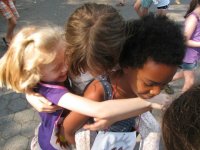Building Social and Emotional Skills in Elementary Students: Passion and Strengths
In this nine-part series, we will look at important factors that influence the happiness and social and emotional learning of elementary school age children. These are very useful in helping students learn, manage emotions better and increase empathy. Each blog features one letter of the acronym HAPPINESS:
H = Happiness
A = Appreciation
P = Passions and Strengths
P = Perspective
I = Inner Meanie, Inner Friend
N = Ninja Mastery
E = Empathy
S = So Similar
S = Share Your Gifts
In this blog, we’ll explore passions and strengths.
Inherent Strength
While the role of education is to give students a broad and foundational knowledge over a wide range of subjects, it is equally important for young people to be aware of and develop their unique strengths. This came to my attention in a personal way when my own daughter was being bullied. As each day became more and more challenging, I went to speak with the school. Even with all best intentions, very little changed. How could my daughter weather the storm when she was being demeaned daily? One thing that worked was helping her become aware of her own strengths and then building on them. It made an enormous difference for her and is a powerful tool that every student should have.
One definition of strength from the Merriam-Webster Dictionary is "a strong attribute or inherent asset." Students who know their inherent attributes and gifts have a huge advantage in school and for their future. Those who are aware of their strengths can build on them more easily, which helps them feel good about themselves, and enjoy greater motivation and happiness. Other advantages of knowing their strengths include:
- A stronger sense of personal identity
- A greater feeling of overall self-confidence
- Recognizing their own strengths, which helps them see that everyone else has unique strengths
- Feelings of appreciation for others
The idea is that everyone has a gift. Let's learn what our own gift is, feel good about it, and appreciate all the different gifts and strengths that others have, too.
Strength Through Practice
Another type of strength is the kind that you feel when you practice something so often that you become strong at it. This is true for many areas, including learning a musical instrument, a new language or a new sport. Your brain actually grows in the regions that correspond to repeated practice, which in turn make it easier to do well in that area. For example, in The Emotional Life of Your Brain, Dr. Richard J. Davidson reports, "The brains of virtuoso violinists show a measurable increase in the size and activity of areas that control the fingers." Practicing does promote strength.
Passion and Engagement
Passion illustrates strengths in action. Merriam-Webster defines it as "a strong liking or desire for or devotion to some activity, object or concept." What are your students passionate about? By knowing these, they can tap into:
- Greater productivity
- Greater joy
What do they like to do in school or on their own time that engages them fully and puts them into an expansive, happy state? According to Harvard researcher Shawn Archer, the brain at positive is 31% more productive than at negative, neutral or stressed. If students can learn to be like detectives and begin noticing the activities that make them happy or that make hours seem like minutes, then they can tap into both greater joy and productivity. Music, reading and even computer work are just some of the ways to ignite students' passions and get them into a flow state. What activities have you noticed that engage your students at this level?
The great thing about giving students a chance to explore their passions and strengths is that they can then make the link to how these strengths help them in day-to-day life. This can directly impact feeling happier with oneself, with friends, family or in social situations at school.
Practical Ideas
- Some strengths come naturally, and some come with practice. Try asking your students to think of two strengths that come naturally to them. Some examples can be that they are friendly, funny, helpful, athletic etc.
- Then ask them to think of one thing that they have practiced so much that they are getting better at it every time. Reading, writing and riding a bike are just a few.
- Have students go around the room and ask different people to reflect back one of their strengths (and write them down); then have them tell the other person one of their strengths. At the end, they will have a list of strengths that their classmates see in them.
With all the negative messages that students receive everyday, it's more important than ever to give them a way to connect with their strengths. My daughter's strength was creativity. Her passion was making soaps, and this gave her the confidence and sense of unique identity that transcended whatever social situation she was facing. Whether or not students find themselves in challenging situations, knowing their strengths and passions is a powerful part of their toolkit for life.
Find lesson plans and additional resources at projecthappiness.org. Meanwhile, please tell us how you identify and nurture your students' strengths.
